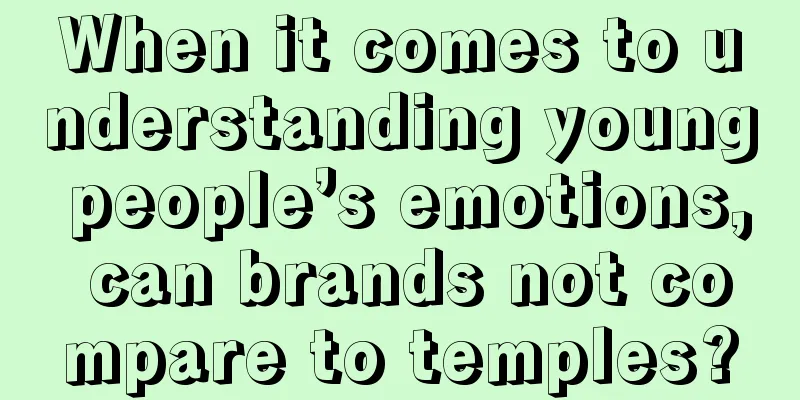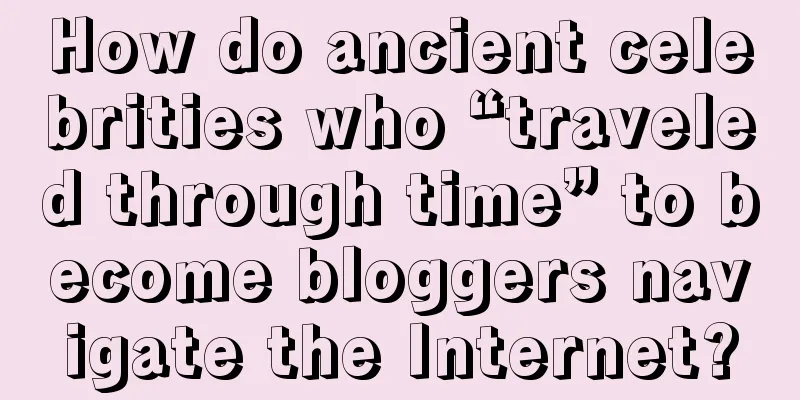When it comes to understanding young people’s emotions, can brands not compare to temples?

Young people are "entering Buddhism". From Beijing's Lama Temple, Tanzhe Temple, Hongluo Temple, Changsha's Kaifu Temple, Xixin Zen Temple, Lushan Temple, to Hangzhou's Lingyin Temple and Faxi Temple, they have all become popular check-in spots for young people. Data from online ticketing platforms show that in 2023, the number of ticket orders for temple-related scenic spots increased by nearly 50% year-on-year, of which those born in the 1980s and 1990s accounted for more than 60%. The term "Buddha-style" first came from a Japanese magazine in 2014, but among today's young people, it is no longer just an adjective. They began to go to temples and pray directly to Buddha. I guess no one expected that Buddhist beads bracelets would become the most popular fashion item nowadays. Every young person who went to the temple to pray to Buddha would ask for a string of Buddhist beads before leaving. The enthusiasm was no less than that of the people who lined up in front of the Apple store a few years ago to buy the new iPhone. What psychological and cultural characteristics of young people are reflected behind burning incense, worshipping Buddha and buying bracelets? What efforts have the temples made behind the temple craze? And can such social culture and supporting actions provide some reference for brands? 1. Internet celebrity temples, hidden marketing expertsIt may seem accidental that temples have become popular online, but if you look deeper, you will find that temples that support Buddha may not be truly Buddhist. Their methods of attracting young people may be more sophisticated than many brands. From the Shaolin Temple, the first internet celebrity among temples, to the Longquan Temple that exploded in popularity in the past few years, to the Lingyin Temple, Faxi Temple, Jiming Temple and other temples that now dominate social media, the marketing methods of temples have gone through three stages : film and television marketing, youthful IP marketing, and social media marketing . There is no need to say much about the popularity of Shaolin Temple. As a frequent guest in film and television dramas, Shaolin Temple has long become synonymous with Chinese temples. Studying how other temples have come from behind may be a more inspiring question for brands. Let's review the marketing strategies of Lingyin Temple and Faxi Temple, two popular temples in Hangzhou. Lingyin Temple, which has long been ranked No. 1 among Hangzhou temples, first became popular because of a job posting. In 2016, Lingyin Temple published a job posting for a new media editor, which quickly became popular on the Internet. Netizens were delighted by the contrast brought about by traditional temples also engaging in new media, and many even took action. This post attracted more than 1,000 applicants, and finally a 90s boy named Zhao Liangui got the job opportunity. It seemed like an accidental event at the time, but the popularity of Lingyin Temple has been maintained to this day, which is inseparable from the marketing planning behind it. After Zhao Liangui joined the company, Lingyin Temple occasionally released his daily work routine - from 8 am to 4 pm, with food and accommodation provided, an irregular workload, and no assessment required, which made many 996 employees envious. Lingyin Temple knows how to spread corporate culture by telling stories with employees' personal experiences. Although not everyone has the opportunity to work at Lingyin Temple, it is still possible to burn incense and worship Buddha. This has made Lingyin Temple a popular tourist attraction, and young people have been coming to burn incense since then. In the past two years, Faxi Temple has used a typical "touching porcelain marketing" strategy. Just like Luckin Coffee to Starbucks and Burger King to McDonald's, with copywriting such as "Don't just know Lingyin Temple when you come to Hangzhou", Faxi Temple has quickly become popular in a short period of time by leveraging the fame of Lingyin Temple. In addition, the latecomer Faxi Temple also needs to find its own "differentiated positioning". While Lingyin Temple is for praying for children and career, Faxi Temple focuses on praying for marriage. Find the pain points of the majority of single users and establish the brand mentality of "Faxi Temple is the most effective for praying for marriage". In the past two years, temples have started to engage in peripheral businesses, with Lingyin Temple and Faxi Temple being the best. Although the peripheral products launched by major temples are roughly the same, such as Buddhist beads and amulets, their packaging and promotion methods are different. First, the product design is differentiated . For example, the 18 seeds launched by Lingyin Temple are made of 18 different jades, which represent the 18 realms of Buddhism, and each bead has a special meaning, such as attracting wealth, peace, marriage... "one string, multiple effects". The way to use the product is also full of ritual sense - you must be respectful before wearing it, and wear it on your left hand for the first three days without touching water. The lotus white bodhi bracelet of Faxi Temple has attracted a group of young people with its appearance. Both temples are good at hunger marketing. The eighteen-seed and lotus white bodhi bracelets are in short supply every day. If you want to buy one, you have to queue for at least half an hour. There are even guides on social media. It can be said that they have made full use of scarcity. It is no accident that temples create hits. They accurately target young people, hit their emotional pain points, and convey Buddhist culture to resonate with young people. Then, they create consumption scenarios by burning incense and worshipping Buddha , which attracts traffic for bracelet amulet products. This series of operations is no less than the brand's marketing strategy. If your brand is still worried about not being able to attract young people, you might as well find inspiration from temple marketing. 2. “Burned-out society” and “placebo effect”In fact, most young people go to temples not because they really believe in Buddhism. So the question is, what do young people go to temples for? A while ago, a picture was circulated on the Internet . There was a long queue in the God of Wealth Temple, but no one was interested in the Marriage Temple . The temple behind is one of the Internet celebrities, the Reclining Buddha Temple in Beijing. Because "Reclining Buddha" is homophonic with "offer", it is sought after by young people. Many people come to burn incense in order to find a job smoothly, but they don't care what affairs the Bodhisattva enshrined in the temple is in charge of. Obviously, young people nowadays go to temples to seek spiritual comfort and solve their current anxieties. What young people are most anxious about nowadays is nothing more than studying, working, and making money. This wave of praying to Buddha seems to be contrary to the trend of lying down that emerged in 2019, but in fact the reasons behind them are the same. The pressure and competition in modern society make young people feel anxious and uneasy. Those who are still struggling are anxious and rely on praying to gods and Buddhas to relieve the immediate pressure; those who can no longer struggle lie down and hide in their comfort zone. We have heard too many times that every year is the most difficult employment season, and every generation is the most difficult generation. Such internal competition cannot be said to have solidified the class, but the degree of internal competition has made society tired. In his book, Korean philosopher Han Bingzhe defines the current society that is "overflowing with enthusiasm" and dominated by competitive performance as a "burnout society." In the process of constantly surpassing ourselves and achieving self-achievement, we are overly active and forced to consume ourselves. Burnout and anxiety are two sides of the same coin.
What people are looking for in the temple is not the solution to real problems, but just an opportunity to release anxiety and soothe their souls. This is also a card that many consumer brands are playing, to express emotions and relieve anxiety. Let their products become a placebo. Under the influence of the "placebo effect", even if the actual status quo does not improve, because users "expect" or "believe" that changes will happen, people's conditions can really be alleviated. 3. When every brand wants to impress young people, how can they make “emotional value” meaningful?The popularity of temple literature among young people has once again made us pay attention to the importance of "emotional value" in brand marketing. But the problem is that many marketing insights often feel bland. How can we more accurately hit the emotional points of young consumers? Combining the phenomenon of "burnout society" and the concept of "placebo effect" mentioned above, Daofa has looked through many cases on the market and found that brands that have achieved positive feedback generally follow a principle: exploring the "body, mind and spirit" internally and seeking "little happiness" externally. In other words, no matter what form of marketing is used, whether it is film and television adaptation or promotional marketing, in the final analysis, the brand needs to be better at at least one of the two: expressing its own values vs understanding users. I believe everyone still remembers the "rhythm master" that was searched almost every year from 2016 to 2018: NetEase Cloud Music. During the years of copyright wars with competitors, NetEase Cloud Music has repeatedly dominated the screen with activities such as subway music reviews, annual listening reports, Jungian psychological tests, and music personality dominant colors. The number of monthly active users has been constantly refreshed, precisely because it has grasped the deep desire of users to be understood and express themselves, and has entered people's lives as a companion. The exploration of "body, mind and spirit" is certainly not limited to music content products. In fact, some categories are inherently endowed with emotional values that are worth exploring. For example, sports products, whether it is shoes, clothing, bags or fitness platforms, all carry a certain sports spirit. The key to differentiation lies in the perspective chosen by the brand. So we see that many well-known brands express themselves from subtle incisions:
As for seeking "small happiness" from the outside, there are many brands of this kind, such as IP trendy toys represented by Pop Mart, "Three Pitfalls" (Hanfu, JK, Lolita), and theme parks represented by Disney and Beijing Universal Studios. Although Lingna Belle and the workers live in different dimensions, she is cute, scheming and versatile. She does not need to deliberately add value. Just her existence and giving everyone a hug can soothe people's hearts. Although drawing a Pop Mart blind box depends entirely on luck, the fun of raising a baby and the "stamp collecting" mechanism are addictive... The product carriers of these brands are ever-changing, but the similarities are that they understand that people's emotions need companionship, support, transfer, elimination and outlet, and they find the brand's positioning through cross-combination. Therefore, from trendy toys with a customer unit price of tens of yuan to three-pit objects with a price of tens of thousands of yuan, from IPs that are more than a hundred years old to the blind box category that has emerged in recent years, they can give target users a certain sense of "meaning" and "ritual". In an age of explosive material supply, real connections between people are truly valuable, and brands that are willing to listen patiently and work hard to heal people's spiritual exhaustion are also a rare species. Every era has its own propositions to be answered. Regardless of whether brands choose to explore internally or externally, they do not have to be trapped in the existing stereotyped understanding of "emotional value", nor do they have to worry about the ever-changing social trends - today it is popular to be Buddhist and go with the flow, but one day wolf culture will become popular again. Just as "fashion is a cycle", people's emotions are always flowing. More often than not, brands start from sincerity, choose the path they believe in and justify themselves, which will bring unexpected gains. Author: Jingmin, Siete, Chu Qing Source public account: Knife Skills Research Institute (ID: DigipontClub), insight into new consumption, empowerment of new brands, analysis of new marketing, and creation of good Chinese brands. |
<<: Behind the popularity of “temple tours”, why do young people love incense?
>>: What is the end point of the e-commerce war?
Recommend
How does Shopee Malaysia set prices? Shopee pricing method
Friends who do cross-border e-commerce should all ...
What are the methods for shipping goods abroad from eBay? A must-read for eBay merchants
eBay provides a vast international market for sell...
Known as the "female version of Brother Yang", with over 10 million fans in half a year, is the comedy drama account going to have another hit?
This article focuses on how to create a hit with a...
When is the Amazon IPI assessment time? How to improve the IPI score?
No matter what platform you open a store on, merch...
What are the cross-border e-commerce payment platforms? Introduction to the five major platforms
Now, to do cross-border e-commerce, you need to no...
To defeat your opponent, you rely on positioning; to defeat your opponent, you rely on conflict!
There are more and more marketing theories, but ma...
Can Amazon settle payments every day? How are payments settled?
For Amazon sellers, it is not only necessary to ch...
This "Dragon Boat Festival" business is booming, a handful of "grass" costs hundreds of yuan, and some merchants earn millions a month
During the Dragon Boat Festival, sales of mugwort-...
Analysis of Xiaohongshu beauty users’ insights
We know that the beauty industry is one of the mos...
What are the requirements for entering Shopee's overseas warehouses? What are the advantages of overseas warehouses?
Shopee is an e-commerce platform in Southeast Asia...
Young people love to watch and brands love to invest in farming variety shows: 4 inspirations for marketers
The author of this article talks about the marketi...
Top foodies are rushing to pay the "entry fee" to food delivery platforms
In the current economic environment, young people&...
What should I do if I don’t know English when opening a store on Amazon?
For merchants who do not understand English, langu...
The number of fans increased by 4 million in 10 days, and "Kaifeng Wangpo" stopped selling goods
Internet celebrity Wang Po became very popular, an...
Is it necessary to send Orange Union Payment on eBay? eBay Orange Union Payment Process
As one of the world's largest online auction a...









